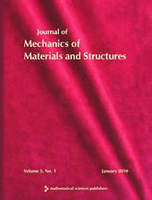
Journal of Mechanics of Materials and Structures
Scope & Guideline
Fostering Academic Excellence in Material Behavior Research.
Introduction
Aims and Scopes
- Mechanics of Materials:
This area encompasses the study of mechanical properties of materials, including stress-strain behavior, fatigue, fracture mechanics, and material characterization techniques. - Structural Analysis:
Focus on the analysis and design of structures under various loading conditions, including static and dynamic loads, as well as the impact of environmental factors on structural integrity. - Advanced Materials:
Research on new materials, such as composites, nanomaterials, and functionally graded materials, which exhibit unique mechanical properties and behaviors. - Computational Mechanics:
Utilization of numerical methods and simulations, including finite element analysis (FEA) and phase-field models, to solve complex mechanical problems and predict material behavior. - Multiscale and Multiphysics Modeling:
Integration of multiple physical phenomena and scales to provide more accurate representations of material and structural behaviors, often involving interactions between mechanical, thermal, and electrical properties. - Experimental Mechanics:
Development and application of experimental techniques to investigate mechanical behavior, including advanced imaging, non-destructive testing, and real-time monitoring.
Trending and Emerging
- Functionally Graded Materials (FGMs):
Research on FGMs has gained significant traction, focusing on their unique properties and applications in various fields, including aerospace and biomedical engineering. - Nanomaterials and Nanostructures:
There is an increasing emphasis on the mechanical behavior of nanomaterials, including their unique properties and potential applications in advanced technologies. - Smart Materials and Structures:
The integration of smart materials, such as piezoelectric and shape-memory alloys, into structural applications is a growing area of interest, especially for active control and sensing. - Multiscale Modeling Approaches:
The trend towards multiscale modeling that bridges atomic-level interactions with macroscopic behavior is becoming more prevalent, allowing for better predictions of material performance. - Dynamic Response and Impact Analysis:
Research focusing on the dynamic response of materials and structures under impact loads is on the rise, driven by the need for improved safety and performance in engineering applications. - Sustainability and Eco-Friendly Materials:
Emerging themes around sustainable practices and the use of eco-friendly materials are gaining attention, reflecting broader societal trends towards environmental responsibility in engineering.
Declining or Waning
- Traditional Material Testing Methods:
There has been a noticeable decrease in papers focusing on classical material testing methods, such as standard tensile or compression tests, as researchers shift towards more advanced and innovative testing techniques. - Static Structural Analysis:
Research that primarily deals with static analysis of structures is becoming less prevalent, with a growing emphasis on dynamic analysis and the effects of time-dependent loading. - Simplistic Theoretical Models:
The use of overly simplistic theoretical models that do not account for complex material behaviors or environmental factors is declining, as there is a greater push for more sophisticated and realistic modeling approaches. - Homogeneous Materials Studies:
There appears to be a waning interest in studies focused solely on homogeneous materials, as the field increasingly explores heterogeneous and composite materials that better reflect real-world applications.
Similar Journals
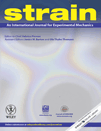
STRAIN
Fostering Excellence in Mechanics of MaterialsSTRAIN is a prestigious peer-reviewed journal published by WILEY, dedicated to advancing the field of mechanical engineering and mechanics of materials. With an ISSN of 0039-2103 and an E-ISSN of 1475-1305, STRAIN has been a pivotal resource for researchers and professionals since its inception in 1965. As of 2023, it holds a commendable categorization in the Q2 quartile rankings for both Mechanical Engineering and Mechanics of Materials, reflecting its significant contribution to the field and ranking in the top percentile of its category. STRAIN aims to disseminate high-quality, innovative research that enhances the understanding of strain phenomena and materials behavior under various conditions. Researchers seeking to publish cutting-edge studies will find a welcoming platform in STRAIN, where they can share their insights with a global audience committed to the evolution of engineering practices. Although it does not offer an Open Access option, its robust editorial standards ensure that all published works adhere to the highest levels of academic integrity and scientific rigor.
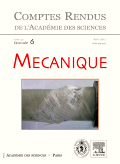
COMPTES RENDUS MECANIQUE
Fostering Collaboration and Innovation in Mechanics and MaterialsCOMPTES RENDUS MECANIQUE, an esteemed journal published by the Académie des Sciences, serves as a critical platform for cutting-edge research in the fields of mechanics and materials science. With an ISSN of 1631-0721 and an E-ISSN of 1873-7234, this open-access journal has gained visibility since its transition to open access in 2020, encouraging a broader dissemination of knowledge within the community. As of 2023, it holds a Q3 ranking in both the Materials Science (Miscellaneous) and Mechanics of Materials categories, according to category quartiles. Given its Scopus rankings—299th out of 398 in Mechanics of Materials and 360th out of 463 in General Materials Science—it provides valuable insights and advancements in these disciplines. Located in Paris, France, the journal caters to researchers, professionals, and students alike, showcasing a diverse range of studies and developments that push the boundaries of knowledge in mechanics. Through its accessible format, COMPTES RENDUS MECANIQUE not only highlights significant findings but also promotes collaboration and innovation across the global scientific community.

INTERNATIONAL JOURNAL OF FRACTURE
Driving Excellence in Fracture Research and ApplicationsInternational Journal of Fracture, published by Springer, stands as a leading peer-reviewed platform dedicated to advancing the field of fracture mechanics and its applications. Since its inception in 1973, this journal has provided a crucial forum for innovative research and discussions, addressing pivotal topics in computational mechanics, mechanics of materials, and modeling and simulation. With a significant impact factor and a Q1 classification in computational mechanics, it ranks impressively within the Scopus metrics, further solidifying its relevance among global researchers and professionals. The journal caters to an international audience by fostering the exchange of knowledge and cutting-edge discoveries, making it an essential resource for those engaged in the latest advancements and applications in material fracture studies. Its commitment to high-quality research ensures that the findings published within its pages not only contribute to academic discourse but also influence real-world engineering and manufacturing practices.
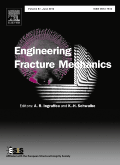
ENGINEERING FRACTURE MECHANICS
Exploring the Depths of Fracture DynamicsENGINEERING FRACTURE MECHANICS, published by Pergamon-Elsevier Science Ltd, is a leading peer-reviewed journal that specializes in the field of fracture mechanics, focusing on the behavior of materials under stress. Established in 1968 and continuing to publish valuable research through 2024, this journal is pivotal for advancing the understanding of fracture mechanisms and their implications across various engineering disciplines. With its impressive impact factor and ranked in the Q1 category for Materials Science, Mechanical Engineering, and Mechanics of Materials, it holds a distinguished position in the academic community, reflected in its high Scopus rankings. Although the journal does not offer Open Access, it provides a wealth of knowledge and insights critical for researchers, professionals, and students aiming to deepen their expertise in the mechanics of materials and innovative engineering solutions.

ACTA MECHANICA
Catalyzing Research for Tomorrow's TechnologiesACTA MECHANICA, published by Springer Wien, is a reputable journal that has been an integral part of the fields of Computational Mechanics and Mechanical Engineering since its inception in 1965. With a strong emphasis on innovative research and advanced methodologies, the journal has established itself in the academic community, currently holding a distinguished Q2 ranking in both categories for 2023. The journal’s ISSN is 0001-5970, with an E-ISSN of 1619-6937. Furthermore, it proudly ranks #26 out of 89 in Computational Mechanics and #217 out of 672 in Mechanical Engineering in the Scopus database, placing it in the top percentiles of its respective fields. Researchers, professionals, and students can access cutting-edge articles that cover a wide range of topics, contributing significantly to ongoing dialogues and discoveries within mechanical disciplines. Though not an open-access journal, ACTA MECHANICA offers a platform for highly qualified researchers to disseminate their work, ensuring that significant findings advance the field's boundaries. For more information, visit the journal’s address at Prinz-Eugen-Strasse 8-10, A-1040 Vienna, AUSTRIA.
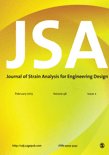
JOURNAL OF STRAIN ANALYSIS FOR ENGINEERING DESIGN
Pioneering Research in Mechanics and Materials Engineering.The Journal of Strain Analysis for Engineering Design, published by SAGE Publications Ltd, is a prestigious academic journal that has been at the forefront of *engineering and applied mathematics* research since its inception in 1965. With a focus on the intricate analysis of strain in engineering design, this journal serves as a vital resource for researchers and professionals seeking to push the boundaries of understanding in mechanics and materials engineering. As of 2023, it enjoys a respectable ranking in its respective fields, including Q2 in *Mechanical Engineering* and *Mechanics of Materials*, and Q3 in *Applied Mathematics* and *Modeling and Simulation*, reflecting its significant contribution to the academic community and relevance in practical applications. Although it is not an open-access journal, its rigorous peer-review process ensures the dissemination of high-quality research. The journal provides a platform for innovative ideas and methodologies, fostering advancements in engineering design and analysis vital for both academia and industry. By bridging theoretical foundations with real-world applications, the Journal of Strain Analysis for Engineering Design remains an essential publication for those dedicated to addressing the complexities of modern engineering challenges.

JOURNAL OF ELASTICITY
Elevating Knowledge in Elasticity Across DisciplinesJOURNAL OF ELASTICITY is a prestigious peer-reviewed journal dedicated to the study and advancement of the field of elasticity and its numerous applications across various disciplines. Published by SPRINGER, and located in the Netherlands, this journal has been a key resource since its inception in 1971, providing critical insights and developments up through 2024. With a commendable impact factor and categorized within the Q2 quartile in areas such as Materials Science, Mechanical Engineering, and Mechanics of Materials, the journal maintains a significant standing in the academic community. Researchers and professionals will find a wealth of knowledge through advanced theoretical and experimental studies published within its pages, contributing to both foundational understanding and practical applications. While currently not an open access publication, the JOURNAL OF ELASTICITY remains an essential platform for innovative research and discussions that shape the future of mechanical sciences.
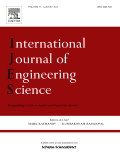
INTERNATIONAL JOURNAL OF ENGINEERING SCIENCE
Pioneering Innovations in Engineering and Materials ScienceInternational Journal of Engineering Science, published by Pergamon-Elsevier Science Ltd in the United Kingdom, stands as a premier platform for pioneering research in the diverse fields of engineering and materials science. Since its inception in 1963, this journal has consistently demonstrated its commitment to advancing academic discourse, maintaining an impressive trajectory that positions it in the Q1 category across multiple engineering disciplines including Mechanical Engineering and Mechanics of Materials as of 2023. With notable Scopus rankings—placing it in the top 5% percentile for Mechanical Engineering and related fields—this journal attracts high-quality, impactful research designed for both industry practitioners and academic scholars. Although it does not currently offer Open Access options, its readership is enriched by comprehensive peer-reviewed articles, fostering a deeper understanding of complex engineering problems and innovative solutions. The International Journal of Engineering Science continues to be an invaluable resource for researchers, professionals, and students committed to pushing the boundaries of knowledge in engineering and materials science.
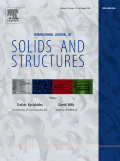
INTERNATIONAL JOURNAL OF SOLIDS AND STRUCTURES
Transforming Ideas into Impactful DiscoveriesINTERNATIONAL JOURNAL OF SOLIDS AND STRUCTURES, published by PERGAMON-ELSEVIER SCIENCE LTD, is a leading academic journal with a strong reputation in the fields of engineering and applied mathematics. Established in 1965 and converging its impact on research through 2024, this journal is highly regarded within Q1 quartile rankings across multiple disciplines, including Applied Mathematics, Condensed Matter Physics, and Mechanical Engineering. With its ISSN 0020-7683 and E-ISSN 1879-2146, the journal is systematically indexed and accessible to a global audience, although it does not currently offer open access options. Researchers, professionals, and students alike benefit from its high-impact research articles, as evidenced by its impressive Scopus rankings in various categories, including a 91st percentile in Applied Mathematics and 81st in Mechanical Engineering. The journal serves as a critical platform for the dissemination of groundbreaking findings in solid and structural mechanics, promoting innovation and collaboration within the scientific community.

Forces in Mechanics
Bridging Theory and Application in MechanicsForces in Mechanics is a premier open access journal published by ELSEVIER that has carved out a significant niche in the realms of Mechanical Engineering and Mechanics of Materials. Established in 2020 and based in the Netherlands, this journal aims to disseminate high-quality research that explores the fundamental principles and applications of forces within mechanical systems. It operates under the ISSN 2666-3597, showcasing a dedication to transparent and accessible research for scholars around the globe. With a 2023 impact factor ranking placing it in the Q2 quartile for both Mechanical Engineering and Mechanics of Materials, the journal is recognized for its contributions to the field, evidenced by its Scopus ranking—285th in Mechanical Engineering and 184th in Mechanics of Materials, placing it in the 57th and 53rd percentiles, respectively. The journal publishes original research articles, reviews, and technical notes, catering to a diverse audience including researchers, practitioners, and students who are keen to advance their knowledge on the dynamics of forces in mechanical contexts. As it converges from 2021 to 2024, Forces in Mechanics remains committed to providing a platform for innovative research and critical discourse, ensuring that all published work is freely available to the global community.